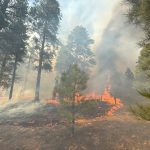
Chronic absenteeism escalated during pandemic
PHOENIX
Spring break kicked off for students three years ago, but upon their return, some didn’t return to the classroom, and some still haven’t fully returned to school.
During the pandemic, the Arizona Department of Education revealed students missing more school than years before. Specialists from the Helios Education Foundation and the superintendent of the Avondale School District came together to talk about the problem they saw.
Chronic absenteeism is missing more than 10% of the school year at the same school a student attends, according to the 2022 Helios Education Foundation report.
Paul G. Perrault, the senior vice president of community impact and learning for the foundation, expanded on chronic absenteeism among students within Arizona, including Native American students. He said Native students miss school at a higher rate than their counterparts.
“A lot of times, it’s because of the location. Many Native American schools within Arizona are in rural areas. These schools did have more school closures, and they had more exposure to Covid and then had bigger policies,” Perrault said.
At the height of the coronavirus pandemic, schools across the country considered the safety of their students, thus shutting down in-person learning.
Location, transportation
With the location being one of the reasons Native students tended to miss more school than other students, Perrault saw transportation as another.
“When we talked to these students, there were other contributing reasons they could not consecutively attend school. Some families did not have a reliable vehicle. Some students might’ve had to stay home to take care of their siblings,” Perrault said.
The 2022 chronic absenteeism report was conducted from research provided by the Arizona Department of Education, which found that enrollment and withdrawal increased the percentage of days a student misses to narrow down chronically absent students to 18%.
At least 7,000 students across Arizona were absent in 2021, based on the 18% guideline according to the report.
“Kids went home in 2020, in 2021, everybody thought things were back to normal, but during that school year, between 24% and 25% of students were still chronically absent, which was dramatically higher than absences in the past,” Perrault said.
High rates of missing school didn’t stop the efforts made by superintendent Betsy Hargrove from the Avondale School District. She also shared her plan to better school attendance.
Hargrove shared an “Awareness and Acceptance Equals Action” plan that showed parents their child is missing more days than they should. Moving forward, the school and parents work together to ensure the child attends school more often.
“Bottom line is there are barriers to come to school whether it’s an economic barrier, whether it’s a distance barrier, whether its extensive circumstance within the home that needs to be navigated differently,” Hargrove said.
Awareness plan
Part of Hargrove’s awareness plan was rewarding students in a tier-like manner for showing up to school and sending home letters so that parents are aware of how many days their child has missed.
“Whatever it might be, I truly believe, and we have found incredible success coming alongside and being a part of a united group to support children and create new behaviors and create new habits and celebrating those,” Hargrove said.
Lenay Dunn, deputy director for the Regional Educational Laboratory West, a research and evaluation organization focused on successful education, agreed with Hargrove regarding community help to get students back to school.
“I think those same evidence-based strategies can support. I think thinking about what can we do to ensure the support happening at the schools. It really is a community initiative,” Dunn said.
Along with recognizing chronic absenteeism in Arizona school districts, school districts must consider the education students receive.
Dunn said, “It may be true that students won’t be held back for being chronically absent, but their grades will slip, and that’s what the issue is.”
The 2022 chronic absenteeism report showed increased chronic absenteeism for vulnerable student populations: economically disadvantaged, English learning, Native American/Alaskan Native, Black/African American, and Hispanic students.
According to Dunn, more missed days from school lowers the grades for the vulnerable student population.
Perrault, Hargrove, and Dunn emphasized the importance of attending school and how to do so and said they want school districts to review the report to support their students better.
Hargrove said, “I don’t believe I’ll ever meet a parent who would not want their child to be successful.”
As a public service, the Navajo Times is making all coverage of the coronavirus pandemic fully available on its website. Please support the Times by subscribing.
How to protect yourself and others.
Why masks work. Which masks are best.
Resources for coronavirus assistance








 Highway 264,
Highway 264, I-40, WB @ Winslow
I-40, WB @ Winslow